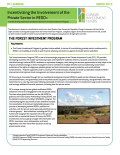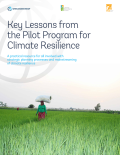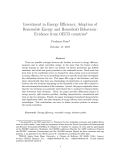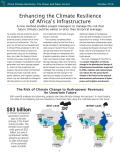
The Forest Investment Program (FIP) is one of three strategic programs of the Climate Investment Funds (CIF). FIP provides developing countries with scaled-up financing to plan and implement readiness reforms and public and private investments, identified through national REDD+ readiness or equivalent strategies, while taking into account opportunities to help adapt to the impacts of climate change on forest ecosystems and to contribute to multiple benefits such as biodiversity conservation, protection of the rights of indigenous peoples groups and local communities, poverty reduction and rural livelihood enhancements.

"Key Lessons from the Pilot Program for Climate Resilience" is a practical resource for all involved with strategic planning processes and mainstreaming of climate resilience.
This resource helps countries bolster the resilience of their infrastructure, natural resources and human development programs, to the effects of climate variability and change. The experiences presented come from the first 7 years of implementing the Pilot Program for Climate Resilience (PPCR) in 18 countries and covering sectors including agriculture and landscapes, water resources, coastal zone, urban development, climate information systems, and other infrastructure.
The top 10 Key Lessons from the PPCR highlight critical and strategic aspects that need to be considered in resilience planning and implementation. These lessons underscore the importance of institutional arrangements; information on climate vulnerabilities; leveraging finance; transforming at scale; engaging stakeholders; dedicated learning fora; engaging private sector; core indicators and monitoring; responsiveness to country context; and where relevant regional programming.



To sustain Africa’s economic growth and accelerate the eradication of extreme poverty, investment in infrastructure is fundamental. The Program for Infrastructure Development in Africa (PIDA), endorsed in 2012 by the continent’s heads of state and government, lays out an ambitious long- term plan for closing Africa’s infrastructure gap, including through major increases in hydroelectric power generation and water storage capacity. Much of this investment will support the construction of long-lived infrastructure (for example, dams, power stations, and irrigation canals), which may be vulnerable to changes in climatic patterns—yet the direction and magnitude of climatic changes remain uncertain. This recently completed effort evaluates—using for the first time a single consistent methodology and a wide range of state-of-the-art future climate scenarios—the impacts of climate change on hydropower and irrigation expansion plans in Africa’s main river basins (Congo, Niger, Nile, Orange, Senegal, Volta, and Zambezi), as well as the effects on the electricity sector across four power pools.
